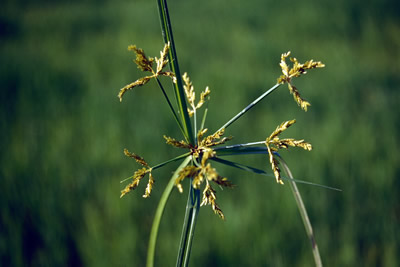Cyperus iria

Latin name
Cyperus iria L.
Family
Cyperaceae
Common name
Rice flatsedge and umbrella sedge
Synonyms
Chlorocyperus iria (L.) Rikl, Cyperus microiria Steud., C. microlepis Baker, C. panicoides Lam., C. santonici Rottb.
Geographical distribution
Asia: China (including Taiwan), Japan, and Korea.
South and Southeast Asia: Bangladesh, Cambodia, India, Indonesia, Lao PDR, Malaysia, Myanmar, Nepal, Pakistan, Philippines, Sri Lanka, Thailand, and Vietnam.
Rest of the world: Australia, Fiji, Swaziland, West Africa.
Morphology
It is a tufted annual herb, or occasionally perennial, with fibrous roots, 15−75 yellowish red roots; 10−70 cm tall.
Stem: sharply 3 angled, tufted, smooth, 5−80 cm high.
Leaf: basal, rough to touch in upper part, linear, flaccid, with gradually tapering point and 3−8 mm wide; sheath reddish or purplish brown, enveloping the stem at base.
Inflorescence: simple or compound umbel composed of numerous erect-spreading 3−10 mm long flattened spikelets.
Fruit: three-angled, 1.0−1.5 mm nut with slightly concave sides, and shiny dark brown to black.
Biology and ecology
The weed thrives in wetland rice, dryland annual crops, and plantation crops.
Rice flatsedge or umbrella sedge multiplies rapidly: can produce 3,000−5,000 seeds per plant, seedlings emerge immediately after rice is sown; flowers month later and can establish second generation in the same season. It flowers throughout the year.
Agricultural importance
An important and widespread weed in South and Southeast Asia.
Ovipositional host of the insects Creatonotus gangis Linnaeus, Leptocorisa acuta (Thunberg), Marasmia exigua (Butler), Mythimna separata (Walker), Nilaparvata lugens (Stål), Nisia carolinensis Fennah, Pseudococcus saccharicola Takahashi, Recilia dorsalis (Motschulsky), Spodoptera mauritia acronyctoides (Guenee), and Stenchaetothrips biformis (Bagnall), diseases Pyricularia oryzae, Rhizoctonia solani, and Sarocladium oryzae, and nematodes Circonemella onoensis, Hirschmanniella oryzae, and Pratylenchus indicus.
Management
Cultural control: hand weeding at earlier stage of growth to prevent flowering and seed production; rotary weeding in transplanted rice during the seedling stage.
Chemical control: Butachlor or oxadiazon after harrowing and sowing of rice and chlorimuron, propanil, or MCPA after emergence.
Selected references
- Galinato MI, Moody K, Piggin CM. 1999. Upland rice weeds of South and Southeast Asia. Manila (Philippines): International Rice Research Institute. 156 p.
- Gokulapalan C, Nair MC. 1983. Collateral hosts of Rhizoctonia solani Kuhn causing sheath blight of rice. Int. Rice Res. Newsl. 8:10.
- Kern JH. 1974. Cyperaceae. Flora Malesiana Ser. 1 7(3): 435-753.
- Merrill ED. 1976. A flora of Manila. Manila (Philippines): Department of the Interior, Bureau of Science. 491 p.
- Moody K. 1989. Weeds reported in rice in South and Southeast Asia. Manila (Philippines): International Rice Research Institute. 442 p.
- Pancho JV, Obien SR. 1995. Manual of ricefield weeds in the Philippines. Muñoz, Nueva Ecija (Philippines): Philippine Rice Research Institute. 543 p.
- Venkitesan TS, Satyakumar Charles J. 1979. The rice root nematode in lowland paddies in Kerala, India. Int. Rice Res. Newsl. 4:21.